Thermophysical Characterization of Efficiency Droop in GaN-Based Light-Emitting Diodes
Abstract
1. Introduction
2. Experimental Method
3. Results and Discussion
4. Conclusions
Author Contributions
Funding
Conflicts of Interest
References
- Yoo, Y.S.; Na, J.H.; Son, S.J.; Cho, Y.H. Effective suppression of efficiency droop in GaN-based light-emitting diodes: Role of significant reduction of carrier density and built-in field. Sci. Rep. 2016, 6, 34586. [Google Scholar] [CrossRef] [PubMed]
- Wang, J.; Wang, L.; Wang, L.; Hao, Z.; Luo, Y.; Dempewolf, A.; Müller, M.; Bertram, F.; Christen, J. An improved carrier rate model to evaluate internal quantum efficiency and analyze efficiency droop origin of InGaN based light-emitting diodes. J. Appl. Phys. 2012, 112, 023107. [Google Scholar] [CrossRef]
- Hu, H.; Zhou, S.; Liu, X.; Gao, Y.; Gui, C.; Liu, S. Effects of GaN/AlGaN/Sputtered AlN nucleation layers on performance of GaN-based ultraviolet light-emitting diodes. Sci. Rep. 2017, 7, 44627. [Google Scholar] [CrossRef] [PubMed]
- Shan, L.; Wei, T.; Sun, Y.; Zhang, Y.; Zhen, A.; Xiong, Z.; Wei, Y.; Yuan, G.; Wnag, J.; Li, J. Super-aligned carbon nanotubes patterned sapphire substrate to improve quantum efficiency of InGaN/GaN light-emitting diodes. Opt. Express 2015, 23, A957–A965. [Google Scholar] [CrossRef] [PubMed]
- Nguyen, H.P.T.; Djavid, M.; Woo, S.Y.; Liu, X.; Connie, A.T.; Sadaf, S.M.; Wang, Q.; Botton, G.A.; Shih, I.; Mi, Z. Engineering the Carrier Dynamics of InGaN Nanowire White Light-Emitting Diodes by Distributed p-AlGaN Electron Blocking Layers. Sci. Rep. 2015, 5, 7744. [Google Scholar] [CrossRef]
- Nee, T.E.; Wang, J.C.; Shen, H.T.; Wu, Y.F. Effect of multiquantum barriers on performance of InGaN/GaNInGaN/GaN multiple-quantum-well light-emitting diodes. J. Appl. Phys. 2007, 102, 033101. [Google Scholar] [CrossRef]
- Kum, H.; Seong, H.K.; Lim, W.; Chun, D.; Kim, Y.I.; Park, Y.; Yoo, G. Wafer-scale Thermodynamically Stable GaN Nanorods via Two-Step Self-Limiting Epitaxy for Optoelectronic Applications. Sci. Rep. 2017, 7, 40893. [Google Scholar] [CrossRef]
- Seo, T.H.; Lee, S.; Min, K.H.; Chandramohan, S.; Park, A.H.; Lee, G.H.; Park, M.; Suh, E.K.; Kim, M.J. The role of graphene formed on silver nanowire transparent conductive electrode in ultra-violet light emitting diodes. Sci. Rep. 2016, 6, 29464. [Google Scholar] [CrossRef]
- Yao, Y.C.; Hwang, J.M.; Yang, Z.P.; Haung, J.Y.; Lin, C.C.; Shen, W.C.; Chou, C.Y.; Wang, M.T.; Huang, C.Y.; Chen, C.Y.; et al. Enhanced external quantum efficiency in GaN-based vertical-type light-emitting diodes by localized surface plasmons. Sci. Rep. 2016, 6, 22659. [Google Scholar] [CrossRef]
- Choi, S.; Kim, H.J.; Kim, S.S.; Liu, J.; Kim, J.; Ryou, J.H.; Dupuis, R.D.; Fischer, A.M.; Ponce, F.A. Improvement of peak quantum efficiency and efficiency droop in III-nitride visible light-emitting diodes with an InAlN electron-blocking layer. J. Appl. Phys. 2010, 96, 221105. [Google Scholar] [CrossRef]
- Ye, D.; Zhang, D.; Wu, C.; Wang, D.; Xu, C.; Zhang, J.; Huang, M. Using a compositionally step graded hole reservoir layer with hole accelerating ability for reducing efficiency droop in GaN-based LEDs. AIP Adv. 2017, 7, 055016. [Google Scholar] [CrossRef]
- Zheng, J.; Li, S.; Chou, C.; Lin, W.; Xun, F.; Guo, F.; Zheng, T.; Li, S.; Kang, J. Direct Observation of the Biaxial Stress Effect on Efficiency Droop in GaN-based Light-emitting Diode under Electrical Injection. Sci. Rep. 2015, 5, 17227. [Google Scholar] [CrossRef]
- Cheng, C.H.; Tzou, A.J.; Chang, J.H.; Chi, Y.C.; Lin, Y.H.; Shih, M.H.; Lee, C.K.; Wu, C.I.; Kuo, H.C.; Chang, C.Y.; et al. Growing GaN LEDs on amorphous SiC buffer with variable C/Si compositions. Sci. Rep. 2016, 6, 19757. [Google Scholar] [CrossRef]
- Bang, J.; Sun, Y.Y.; Song, J.H.; Zhang, S.B. Carrier-induced transient defect mechanism for non-radiative recombination in InGaN light-emitting devices. Sci. Rep. 2016, 6, 24404. [Google Scholar] [CrossRef] [PubMed]
- Oh, M.; Jin, W.Y.; Jeong, H.J.; Jeong, M.S.; Kang, J.W.; Kim, H. Silver Nanowire Transparent Conductive Electrodes for High-Efficiency III-Nitride Light-Emitting Diodes. Sci. Rep. 2015, 5, 13483. [Google Scholar] [CrossRef]
- Xing, Y.; Wang, L.; Yang, D.; Wang, Z.; Hao, Z.; Sun, C.; Xiong, B.; Luo, Y.; Han, Y.; Wang, J.; et al. A novel model on time-resolved photoluminescence measurements of polar InGaN/GaN multi-quantum-well structures. Sci. Rep. 2017, 7, 45082. [Google Scholar] [CrossRef] [PubMed]
- Bao, W.; Su, Z.; Zheng, C.; Ning, J.; Xu, S. Carrier Localization Effects in InGaN/GaN Multiple-Quantum-Wells LED Nanowires: Luminescence Quantum Efficiency Improvement and “Negative” Thermal Activation Energy. Sci. Rep. 2016, 6, 34545. [Google Scholar] [CrossRef] [PubMed]
- Li, H.; Cheng, H.Y.; Chen, W.L.; Huang, Y.H.; Li, C.K.; Chang, C.Y.; Wu, Y.R.; Lu, T.C.; Chang, Y.M. Three dimensional characterization of GaN-based light emitting diode grown on patterned sapphire substrate by confocal Raman and photoluminescence spectromicroscopy. Sci. Rep. 2017, 7, 45519. [Google Scholar] [CrossRef]
- Jeong, H.; Jeong, H.J.; Oh, H.M.; Hong, C.H.; Suh, E.K.; Lerondel, G.; Jeong, M.S. Carrier localization in In-rich InGaN/GaN multiple quantum wells for green light-emitting diodes. Sci. Rep. 2015, 5, 9373. [Google Scholar] [CrossRef]
- Deng, Z.; Jiang, Y.; Ma, Z.; Wang, W.; Jia, H.; Zhou, J.; Chen, H. A novel wavelength-adjusting method in InGaN-based light-emitting diodes. Sci. Rep. 2013, 3, 3389. [Google Scholar] [CrossRef]
- Ryu, H.Y.; Jeon, K.S.; Kang, M.G.; Yuh, H.K.; Choi, Y.H.; Lee, J.S. A comparative study of efficiency droop and internal electric field for InGaN blue lighting-emitting diodes on silicon and sapphire substrates. Sci. Rep. 2017, 7, 44814. [Google Scholar] [CrossRef]
- Jeong, H.; Jeong, S.Y.; Park, D.J.; Jeong, H.J.; Jeong, S.; Han, J.T.; Jeong, H.J.; Yang, S.; Kim, H.Y.; Baeg, K.J.; et al. Suppressing spontaneous polarization of p-GaN by graphene oxide passivation: Augmented light output of GaN UV-LED. Sci. Rep. 2015, 5, 7778. [Google Scholar] [CrossRef] [PubMed]
- Tian, P.; McKendry, J.J.D.; Herrnsdorf, J.; Watson, S.; Ferreira, R.; Watson, I.M.; Gu, E.; Kelly, A.E.; Dawson, M.D. Temperature-dependent efficiency droop of blue InGaN micro-light emitting diodes. Appl. Phys. Lett. 2014, 105, 171107. [Google Scholar] [CrossRef]
- Meyaard, D.S.; Shan, Q.; Cho, J.; Schubert, E.F.; Han, S.H.; Kim, M.H.; Sone, C.; Oh, S.J.; Kim, J.K. Temperature dependent efficiency droop in GaInN light-emitting diodes with different current densities. Appl. Phys. Lett. 2012, 100, 081106. [Google Scholar] [CrossRef]
- Hader, J.; Moloney, J.V.; Koch, S.W. Density-activated defect recombination as a possible explanation for the efficiency droop in GaN-based diodes. Appl. Phys. Lett. 2011, 99, 181127. [Google Scholar] [CrossRef]
- Yang, J.; Xi, L.; Qiu, W.; Wu, L.; Shi, X.; Chen, L.; Yang, J.; Zhang, W.; Uher, C.; Singh, D.J. On the tuning of electrical and thermal transport in thermoelectrics: An integrated theory–experiment perspective. NPJ Comput. Mater. 2016, 2, 15015. [Google Scholar] [CrossRef]
- Jin, X.; Zheng, L.; Ram, R.J. Irreversible Thermodynamic Bound for the Efficiency of Light-Emitting Diodes. Phys. Rev. Appl. 2017, 8, 014017. [Google Scholar]
- Kim, T.; Seong, T.Y.; Kwon, O. Investigating the origin of efficiency droop by profiling the voltage across the multi-quantum well of an operating light-emitting diode. Appl. Phys. Lett. 2016, 108, 231101. [Google Scholar] [CrossRef]
- Mickevičius, J.; Jurkevičius, J.; Kadys, A.; Tamulaitis, G.; Shur, M.; Shatalov, M.; Yang, J.; Gaska, R. Temperature-dependent efficiency droop in AlGaN epitaxial layers and quantum wells. AIP Adv. 2016, 6, 045212. [Google Scholar] [CrossRef]
- Groot, S.R.D. Thermodynamics of Irreversible Processes; North-Holland Publishing Co.: Amsterdam, The Netherlands, 1951. [Google Scholar]
- Born, M.; Huang, K. Dynamic Theory of Crystal Lattices; Oxford University: London, UK, 1954. [Google Scholar]
- Oksanen, J.; Tulkki, J. Thermophotonic heat pump—a theoretical model and numerical simulations. Nat. Photonics 2015, 9, 782. [Google Scholar] [CrossRef]
- Xue, J.; Zhao, Y.; Oh, S.H.; Herrington, W.F.; Speck, J.S. Thermally enhanced blue light-emitting diode. Appl. Phys. Lett. 2015, 107, 121109. [Google Scholar] [CrossRef]
- Ziman, J.M. Electrons and Phonons; Oxford University Press: London, UK, 2001. [Google Scholar]
- Adachi, S. Properties of Group-IV, III-V and II-VI Semiconductors; John Wiley & Sons, Inc.: Chichester, UK, 2005. [Google Scholar]
- Kittel, C. Introduction to Solid State Physics, 8th ed.; John Wiley & Sons, Inc.: New York, NY, USA, 1956. [Google Scholar]
- Nguyen, H.P.T.; Cui, K.; Zhang, S.; Djavid, M.; Korinek, A.; Botton, G.A.; Mi, Z. Controlling Electron Overflow in Phosphor-Free InGaN/GaN Nanowire White Light-Emitting Diodes. Nano Lett. 2012, 12, 1317. [Google Scholar] [CrossRef]
- Sizov, D.S.; Bhat, R.; Zakharian, A.; Song, K.; Allen, D.E.; Coleman, S.; Zah, C. Carrier Transport in InGaN MQWs of Aquamarine- and Green-Laser Diodes. IEEE J. Sel. Top. Quantum Electron. 2011, 17, 1077. [Google Scholar] [CrossRef]
- Bardeen, J. Electrical Conductivity of Metals. J. Appl. Phys. 1940, 11, 88. [Google Scholar] [CrossRef]
- Ansari, I.A. Numerical solution of Bloch-Gruneisen function to determine the contribution of electron-phonon interaction in polycrystalline MgB2 superconductor. Phys. C 2010, 470, 508. [Google Scholar] [CrossRef]
- Otsuji, N.; Fujiwar, K. Electroluminescence efficiency of blue InGaN/GaN quantum-well diodes with and without an n-InGaN electron reservoir layer. J. Appl. Phys. 2006, 100, 113105. [Google Scholar] [CrossRef]
- Hayer, A.; Köhler, A.; Arisi, E.; Bergenti, I.; Dediu, A.; Taliani, C.; Al-Suti, M.; Khan, M.S. Polymer light-emitting diodes with spin-polarised charge injection. Synth. Met. 2004, 147, 155. [Google Scholar] [CrossRef]
- Liu, J.; Tam, W.S.; Wong, H.; Filip, V. Temperature-dependent light-emitting characteristics of InGaN/GaN diodes. Microelectron. Reliab. 2009, 49, 38. [Google Scholar] [CrossRef]
- Chung, D.H.; Hur, S.W.; Kim, S.K.; Lee, J.U.; Kim, C.H.; Hong, J.W.; Kim, T.W. Temperature-dependent electrical properties of organic light-emitting diodes depending on cathodes. Curr. Appl. Phys. 2004, 4, 667–670. [Google Scholar] [CrossRef]
- Wang, C.H.; Chen, J.R.; Chiu, C.H.; Kuo, H.C.; Li, Y.L.; Lu, T.C.; Wang, S.C. Temperature-Dependent Electroluminescence Efficiency in Blue InGaN–GaN Light-Emitting Diodes With Different Well Widths. IEEE Photonic. Technol. Lett. 2010, 22, 236–238. [Google Scholar] [CrossRef]
- Han, D.P.; Zheng, D.G.; Oh, C.H.; Kim, H.; Shim, J.I.; Shin, D.S.; Kim, K.S. Nonradiative recombination mechanisms in InGaN/GaN-based light-emitting diodes investigated by temperature-dependent measurements. Appl. Phys. Lett. 2014, 14, 151108. [Google Scholar] [CrossRef]
- Titkov, I.E.; Karpov, S.Y.; Yadav, A.; Zerova, V.L.; Zulonas, M.; Galler, B.; Strassburg, M.; Pietzonka, I.; Lugauer, H.J.; Rafailov, E.U. Temperature-Dependent Internal Quantum Efficiency of Blue High-Brightness Light-Emitting Diodes. IEEE J. Quantum Electron. 2014, 50, 911–920. [Google Scholar] [CrossRef]

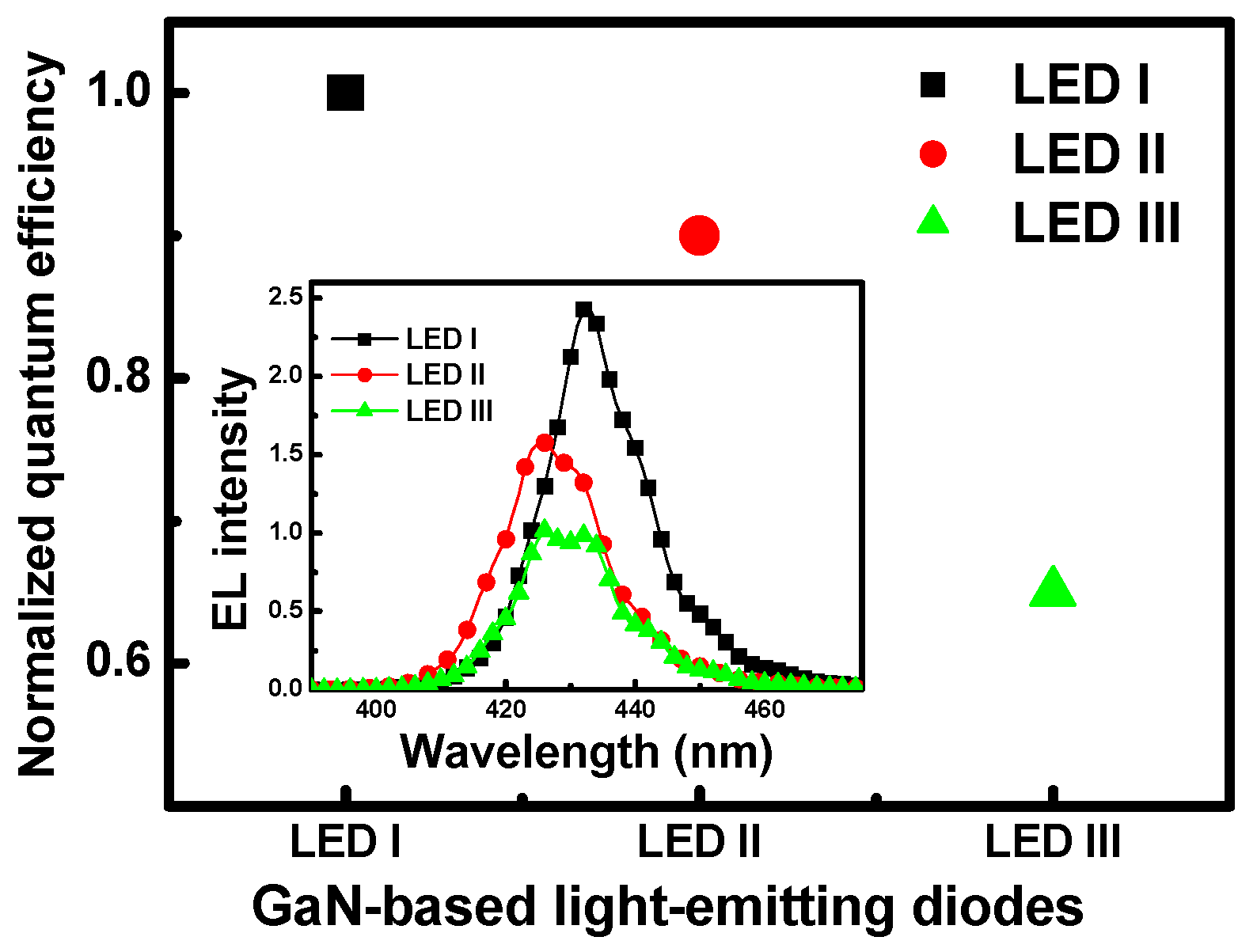
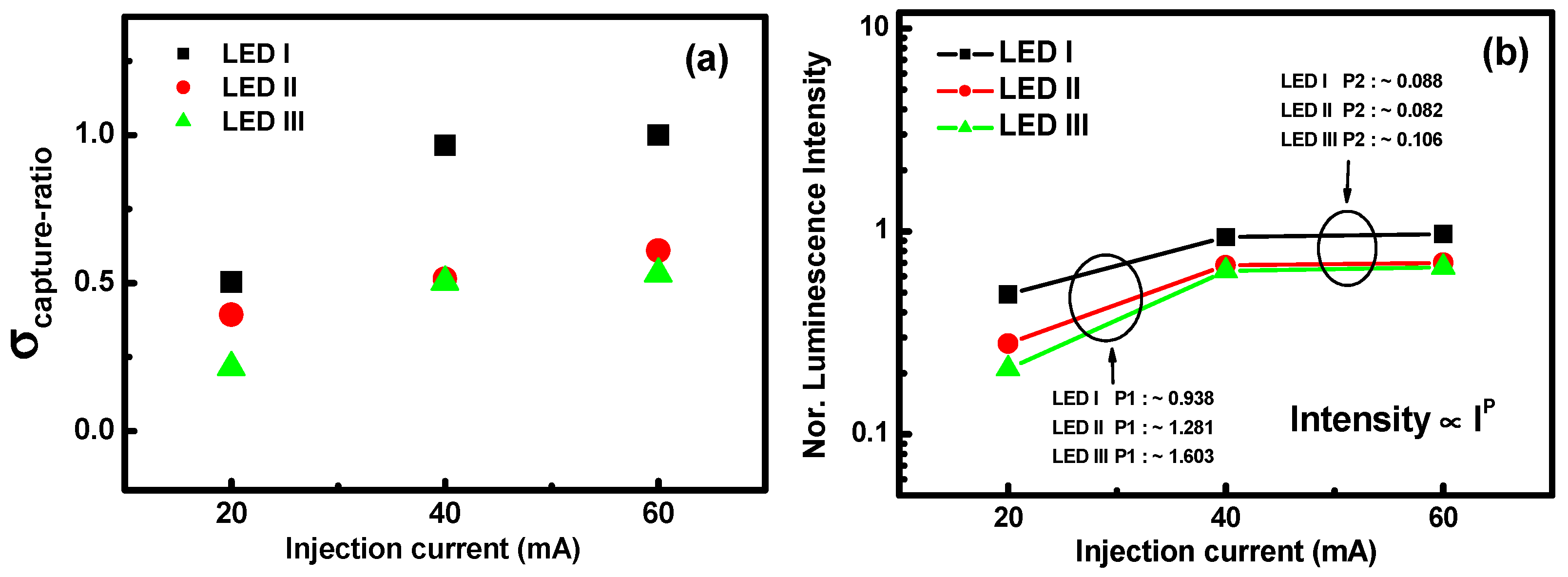
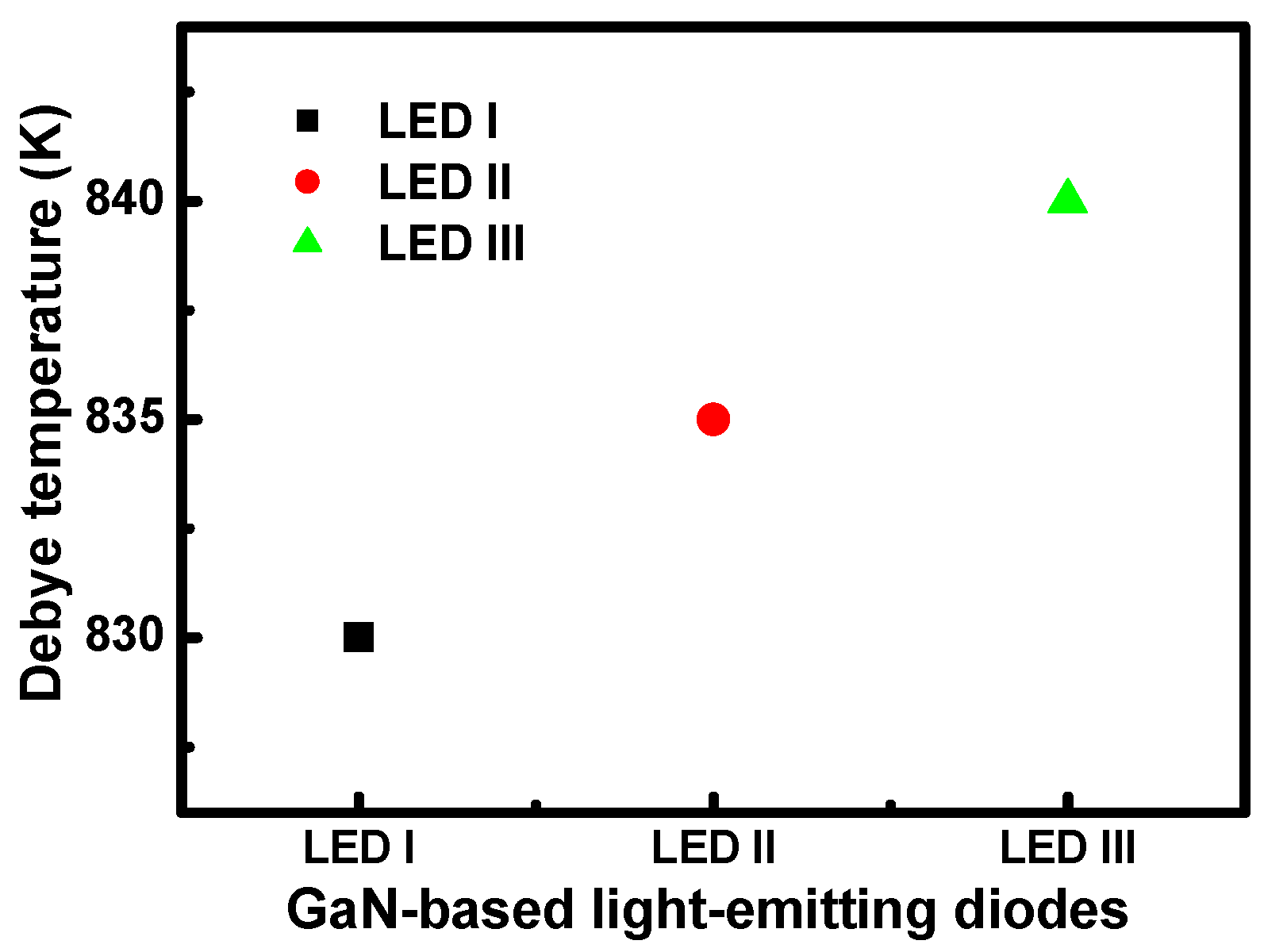

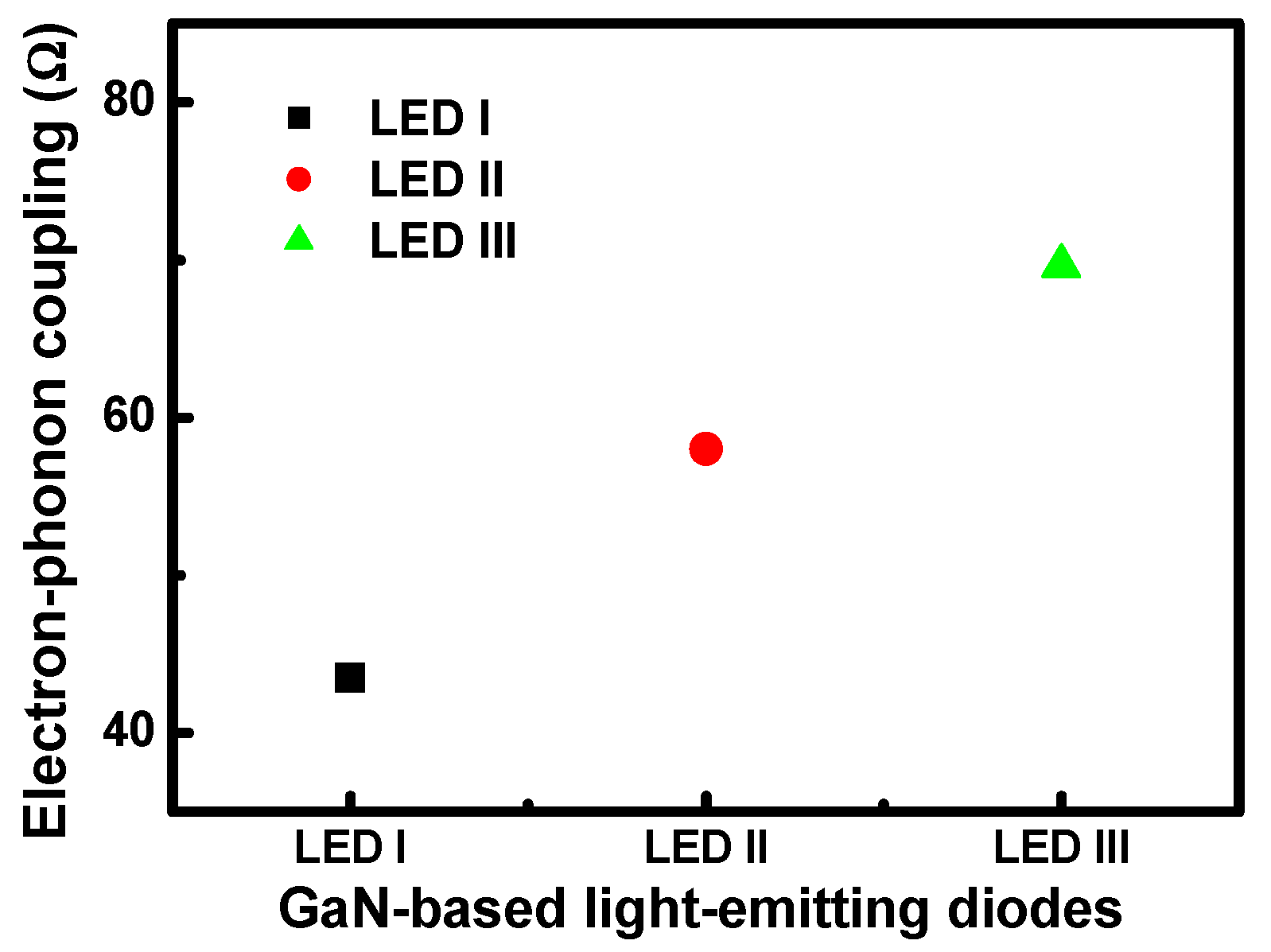
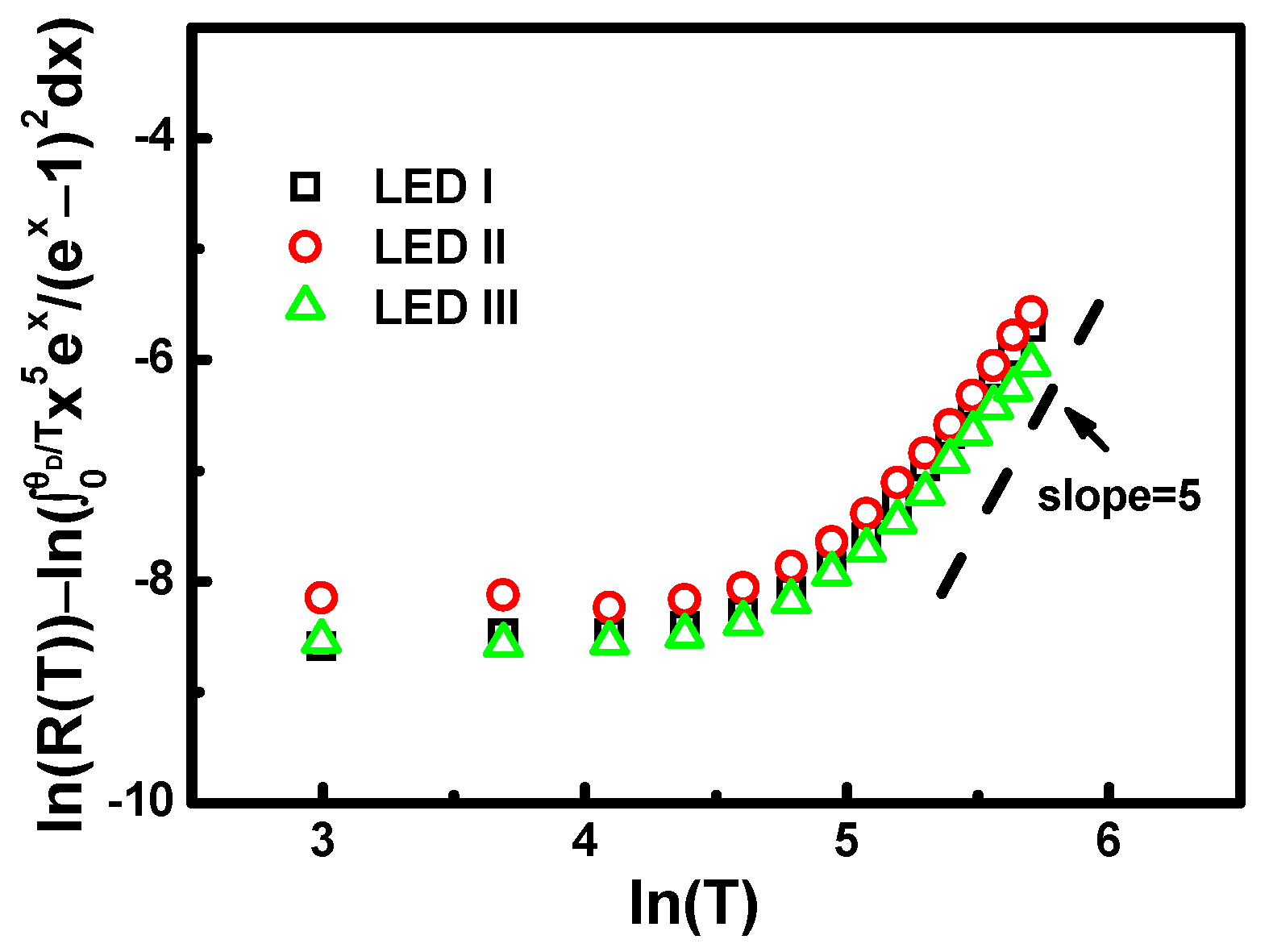

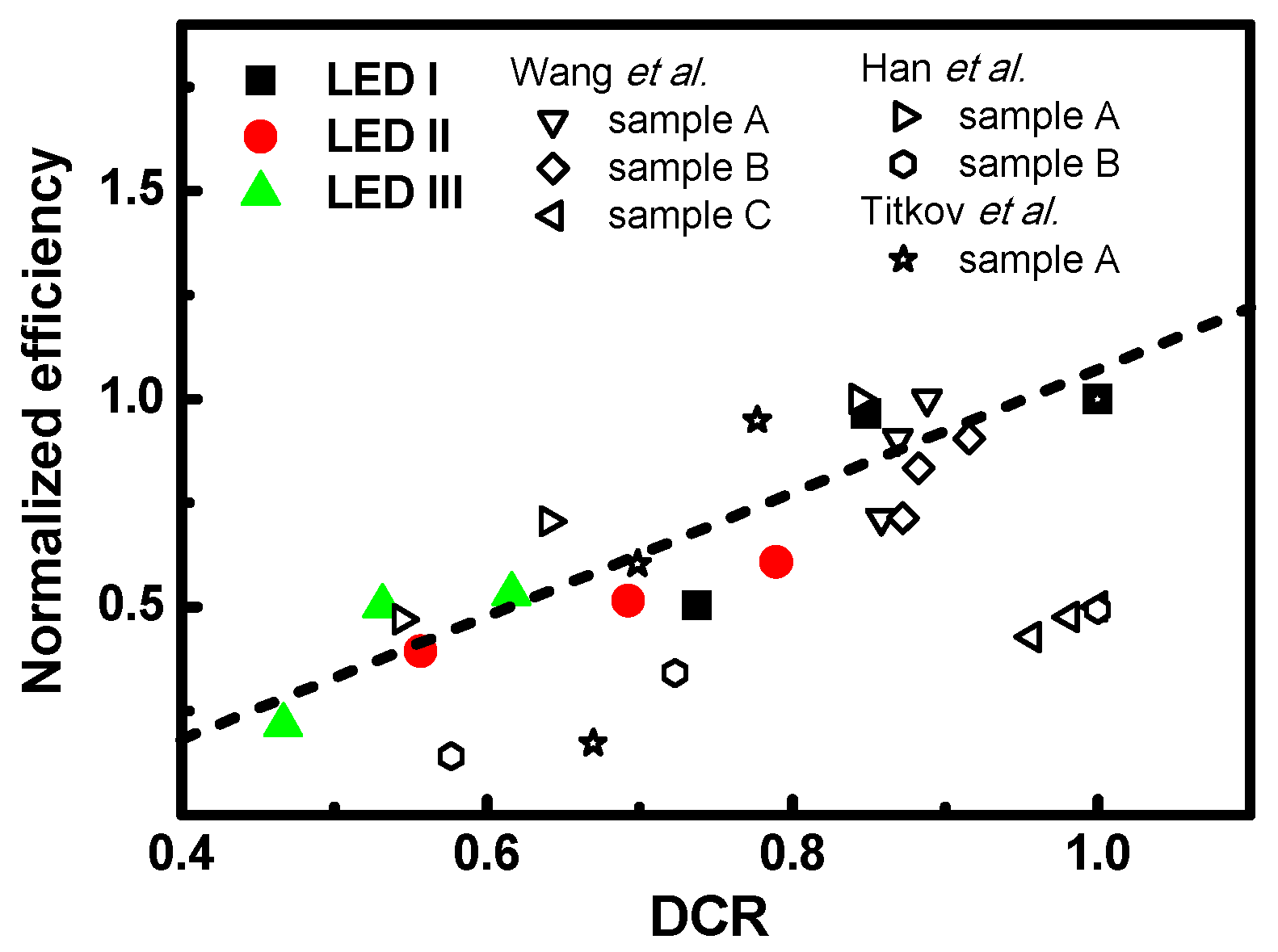
| Samples | θD | α |
|---|---|---|
| Otsuju et al. [41] | ||
| A | 800 | 63.8 |
| B | 750 | 52.2 |
| Hayer et al. [42] | ||
| A | 415 | 1.4 |
| B | 960 | 26.8 |
| Liu et al. [43] | ||
| A | 750 | 0.57 |
| B | 730 | 0.29 |
| Chung et al. [44] | ||
| A | 660 | 2.79 |
| B | 620 | 1.68 |
| C | 600 | 1.13 |
| Samples | Injection Current | θD | α |
|---|---|---|---|
| Wang et al. [45] | |||
| A | 20 mA | 810 | 76.2 |
| 40 mA | 780 | 68 | |
| 60 mA | 760 | 65 | |
| B | 20 mA | 800 | 73 |
| 40 mA | 750 | 64 | |
| 60 mA | 740 | 63 | |
| C | 20 mA | 790 | 69 |
| 40 mA | 740 | 63 | |
| 60 mA | 730 | 61 | |
| Han et al. [46] | |||
| A | 20 mA | 860 | 50 |
| 40 mA | 810 | 40 | |
| 60 mA | 800 | 30 | |
| B | 20 mA | 820 | 45 |
| 40 mA | 800 | 35 | |
| 60 mA | 790 | 25 | |
| Titkov et al. [47] | |||
| A | 1 mA | 820 | 70 |
| 10 mA | 815 | 60 | |
| 100 mA | 800 | 30 |
Publisher’s Note: MDPI stays neutral with regard to jurisdictional claims in published maps and institutional affiliations. |
© 2021 by the authors. Licensee MDPI, Basel, Switzerland. This article is an open access article distributed under the terms and conditions of the Creative Commons Attribution (CC BY) license (https://creativecommons.org/licenses/by/4.0/).
Share and Cite
Nee, T.-E.; Wang, J.-C.; Zhong, B.-Y.; Hsiao, J.-J.; Wu, Y.-F. Thermophysical Characterization of Efficiency Droop in GaN-Based Light-Emitting Diodes. Nanomaterials 2021, 11, 1449. https://doi.org/10.3390/nano11061449
Nee T-E, Wang J-C, Zhong B-Y, Hsiao J-J, Wu Y-F. Thermophysical Characterization of Efficiency Droop in GaN-Based Light-Emitting Diodes. Nanomaterials. 2021; 11(6):1449. https://doi.org/10.3390/nano11061449
Chicago/Turabian StyleNee, Tzer-En, Jen-Cheng Wang, Bo-Yan Zhong, Jui-Ju Hsiao, and Ya-Fen Wu. 2021. "Thermophysical Characterization of Efficiency Droop in GaN-Based Light-Emitting Diodes" Nanomaterials 11, no. 6: 1449. https://doi.org/10.3390/nano11061449
APA StyleNee, T.-E., Wang, J.-C., Zhong, B.-Y., Hsiao, J.-J., & Wu, Y.-F. (2021). Thermophysical Characterization of Efficiency Droop in GaN-Based Light-Emitting Diodes. Nanomaterials, 11(6), 1449. https://doi.org/10.3390/nano11061449






